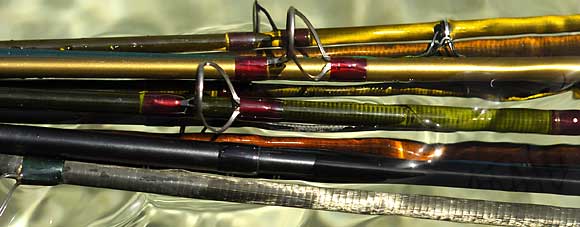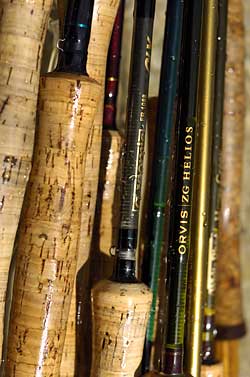Choosing a Fly Fishing Rod

FLY RODS are designed to cast a fly to fish by building momentum in a fly line and controlling its direction and distance. They also have to assist in fighting a fish, and so the size and strength of the fish you seek to catch — whether they are 9-inch brook trout or 80-pound tarpon — also help determine appropriate size and stiffness.
Most modern fly rods come in a variety of lengths and are sized by “weight,” as measured by the size of fly line the manufacturer believes is most suitable for a given rod. A 5-weight rod is designed to cast a 5-weight line, and a 10-weight rod performs best with a 10-weight line. The different line weights match the stiffness or load characteristics of the fly rod, and the difference between rod sizes becomes progressively larger as the size goes up, because difference in line weights also becomes progressively larger (the difference between a 2- and 3-weight line is much smaller than the difference between an 11- and 12-weight). Generally speaking, the heavier the fly line, the stiffer a rod has to be in order to cast it well. However, even within the same weight category, rods can have different flex profiles or “actions.”
A rod’s “action” is a term that has been applied variously to the stiffness, speed of “recovery” (how quick it stops moving at the end of the cast), and tendency to flex in specific areas. In any given rod size, some rods may be very stiff in near the grip (the “butt” section) and have very flexible tips, while others will flex in the mid-section of the rod, and others are more consistently stiff throughout their entire length. Most fly rod manufacturers have dropped the rather subjective term “action” and instead refer to a rod’s performance characteristics by describing the tendency of the rod to flex in different areas: you may hear a rod referred to as having a “soft tip,” a “progressive taper,” “fast tip,” “stiff butt,” “mid flex,” or “tip flex” — none of them very helpful terms in themselves unless we look at why rods are manufactured with different performance goals.
A well-designed and -built rod will always load well with the specified line. When a rod is used for casting its matching line with a fly attached, it should perform just as well at 20 feet as at 80 feet. But a rod that only casts well at long distances is probably stiffer, and one that performs well at close distances is typically soft. That’s because softer, or “slower,” rods allow the caster to feel the loading of the rod more quickly, with less line out of the rod tip. Long casts, on the other hand, tend to benefit from having more line out of the rod tip (there’s more weight to throw), and a stiff rod makes holding more line in the air easier.
Let’s assume the rod is built to handle the right fly line exactly. It casts well in close, and it has the backbone to cast well at long distances. This rod is said to have the right “load” characteristics for the specified line. A rod manufacturer can then customize this rod’s design by deciding where they want the rod to bend the most or the least. Making the rod flex or bend in the tip, mid-, or butt section of the rod can be used to further define the rod for the caster, either to match individual casting styles, or to match the needs of specific fishing situations.
So you have an idea of how this works, let’s look at the two ends of the spectrum:
In the first situation you are looking for a rod that you’ll use for small trout streams, close-in fishing, and smaller fish. The flies you are using are light and small, sizes 12 to 20. You want this rod to cast well in close and you will rarely need it to cast further than 30 feet. You also want the rod to delicately present your flies to rising fish, and when you hook one you want to feel the fish on the rod. The perfect match for this fishing would be a rod that flexes from the mid to butt section of the rod, usually referred to as a “slow” or “traditional” action rod. A rod that bends in the mid-section of the rod may be suitable as well. You don’t need a stiff butt section for fighting the fish, but you do want a rod that you can “feel” right when you get the leader out of the rod tip, and you definitely want it to feel the momentum in the line once you get it out to 20 or 30 feet. 2-, 3- and 4-weight rods are perfect for this.
In the second situation you are looking for a rod to take bonefishing. You know these fish are strong and fast, that they can get up to 10 pounds in weight and can attain speeds up to 30 miles-per-hour, and that you’ll have to contend with wind while you are casting. The flies you will be using range from size 2 to 6, and they may have some weight added to them. All this means you should look at a rod with a butt section stiff enough to quickly land these fish and a flex profile that puts most of the bend in the tip to mid-section. A rod that flexes in the tip is often referred to as a ‘tip flex,’ or ‘tippy,’ or ‘fast action’. These rods flex progressively toward the mid-section as more and more line is cast. You’ll also want a rod that is on the high side of the “load range” — casting better with 20 to 30 feet of line out of the rod tip than your typical “slow” rod will. In this situation an 8- or 9-weight rod is a perfect match.
Complex rod tapers and flex profiles are a relatively new thing in fly fishing. Before the advent of PVC fly lines, there were few variations in fly lines and therefore little need to create rods with special performance characteristics. In the past fifty years, fly fishing has also come to include the pursuit of a greater variety of species in a wider variety of fishing situations. While all fly rods can be categorized as either single-handed or two-handed fly rods — two-handed rods and techniques having first emerged in Scotland as a way to cover large areas of water — the number of ways in which fly rod designers have customized rod performance to match a target species and fishing style are too numerous to mention. Choosing a fly rod becomes a challenge not just because of subtle differences in performance characteristics, but also because each manufacturer tends to favor their own system of description.
Step by Step
Follow these simple guidelines for determining which fly rod is right for you.
First, decide on size by deciding what species you are most likely to fish for. If you are fishing primarily for trout, but you want an all-around rod that can be used for small brook trout as well as 20-inchers and maybe throw some small streamers, a 5-weight is a good choice to start with. If you are buying a rod specifically fishing for smaller native trout in high mountain streams, a 3- or 4-weight is a better choice. And if you are going to pursue salmon and large rainbow trout in Alaska, anything smaller than a 7-weight is probably too small. For saltwater fly fishing, typical choices would be an 8-weight rod for bonefish, a 10-weight rod for permit, small tarpon, and barracuda, and a 12-weight rod for tarpon. The larger the fish, the more important the question of how effective a rod is as a fish-fighting tool. The most versatile all-round rod length is a 9-foot rod. You may see other sizes of single-handed rods ranging from 7 feet all the way to 10 feet, but most fly fishers are happiest with a 9-foot rod unless they like a short rod for fishing brushy creeks or want a longer rod for specialized techniques, such as certain types of nymph fishing.
Next, decide whether you want to fish with a rod made with carbon graphite fiber or one made of the more traditional split bamboo (also referred to as “cane”). Bamboo rods appeal to anglers who value custom craftsmanship and a lighter, slower, more classic casting style. In almost all cases they are more expensive than their high-tech counterparts, but their high prices have more to do with the skills required to make them than the price of their materials or their performance.
Third, ask yourself if you need a 3- or 4-piece rod — to stuff inside a suitcase, strap onto a backpack, or carry on a plane — or whether a 2-piece rod, which you may leave strung up for the entire season, is more convenient.
Once you’ve decided your preference for size, length, construction, and number of pieces, think about price. Some manufacturers specialize in “affordable” fly rods, while others build primarily high-end rods. You can pay under one hundred dollars for a rod from a big box retailer like Bass Pro, or you can pay up to $700 for a fly rod from Sage, Orvis, Loomis or any of the top-end manufacturers (although they each sell rods at a variety of price points). In general, the best-performing rods made with better materials cost more. But if you are just starting out in fly fishing, you may not be able to cast a $500 rod any better than a $150 rod, and many expert fly casters prefer rods that are in the middle of a manufacturer’s price range.
When you’ve decided what you want to pay, it’s time to look closely at the offerings of the various manufacturers. Remember what we said near the beginning of this article: individual manufacturers tend to have unique performance standards that they apply to their entire line of rods. Fly fishers often become attached to a specific brand of rod, and it is because the designers for that brand tend to favor certain characteristics over others. Once you’ve determined which manufacturers make the type of rod you’re looking for in the price range you’re comfortable with, head down to the local fly shop and begin casting the various brands. An experienced caster will almost immediately know whether a given rod feels “right,” fitting their current ability level and style of casting. Novices should simply look for a rod that feels good in their hand and makes them want to continue casting. In both cases, the final choice might be influenced by cosmetics, price point, or the manufacturer’s repair and warranty policy.












